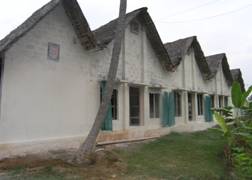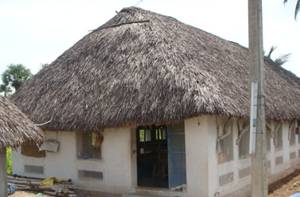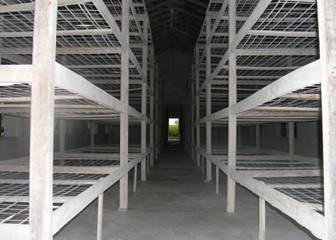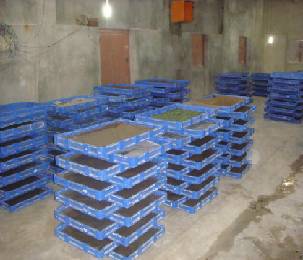REARING HOUSE
Rearing House
-
A separate house is ideal for rearing of silkworm
-
The rearing house should have sufficient number of windows to permit cross ventilation.
-
Provision should be made to make it air tight for proper disinfection.
-
Rearing house has to be built in such a way to provide optimum temperature of 26-28º c and RH of 60-70% for the growth of silkworm at minimum operational cost
Important principles
The most important principles to be remembered in silkworm rearing house are :
Avoid
* Damp condition
* Stagnation of air
* Direct and strong drift of air
* Exposure to bright sun light and radiation
Ensure
* An equable temperature and humidity
* Good ventilation.
Features:
-
Rearing house should be built depending on the brusing capacity and the method of rearing. The rearing area of 2 sq.ft/ dfl for floor rearing and 3 sq. ft/ dfl for shoot rearing is the general criteria.
-
Rearing house should have a main rearing hall, an ante room (8 x 8 ft) and leaf preservation room. Maintaining a separate chawki room (a must for two- plot rearing system; rearing room of size 10’ x 14’ with a height of 9-10 ft for an acre of garden) ideal.
-
Rearing house should face east-west direction.
-
Rearing houose should have facilities to maintain the required environmental conditions.
-
Growing trees around rearing house helps to maintain favourable environment
-
Rearing house should be constructed taking consideration he following points such as effective is disinfection, washable floor, etc.
-
480 sq.ft area is required for rearing 100 dfls.
Preparation of rearing house
-
Rearing room is to be kept ready after disinfection atleast 3-4 days in advance of commencement of rearing.
-
Preconditioning of the rearing house is essential ie, arrangement of rearing appliances and provision of essential environmental conditions one day in advance.
Preparation for brushing
- Before commencement of each rearing, the rearing equipments and rearing houses must be thoroughly washed and disinfected with chlorine dioxide.
- Chlorine dioxide is sprayed on equipments, walls, roof and floor uniformly to destroy the disease causing organisms.
- The rooms should be kept closed for about 24 hours after disinfection.
- The doors and windows should be kept open at least for 24 hours before commencement of rearing to avoid traces of disinfectants.
- To disinfect rearing room and rearing appliances, chlorine dioxide can be used. 500 ml of chloride dioxide is mixed with 50 g of activator and this is dissolved in 20 litres of water. To this, 100 g of lime powder has to be mixed.
Rearing appliances
Non recurring (General)
- Disinfection mask and protective gum shes
- Sprayer for disinfection
- Room heater
- Water air cooler
- Kerosene blow lap
- Wet and dry thermometer
- 6” forceps
Non-recurring (specific)
- Egg transportation box
- Egg incubation chamber
- Loose egg incubation frame
- Black box
- Chawki rearing trays
- Rearing bottom stand
- Feeding Stand
- Ant wells
- Leaf chopping board
- Leaf chopping knife
- Leaf mat
- Bed cleaning nets
- Earthen pot
- Litter basket
- Late age rearing trays
- Rearing stand
- Shoot rearing rack
- Chandrike
- Plastic basin
- Buckets
- Mug
- Plastic box
- Foam pads
- Foot rugs
- Leaf chamber for late age
- Leaf basket
- Cleaning nets
Recurring
- Paraffin paper
- Formalin
- Bleaching powder
- Lime powder
- Bed disinfectants
- Slides and cover slips
- Gunny cloth
- Cora cloth
|




